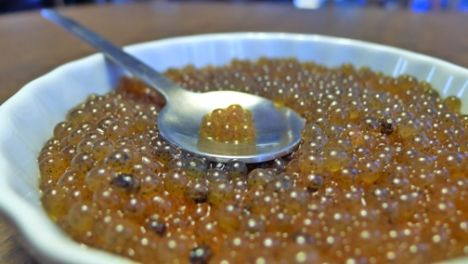
Vanilla syrup
1/4 cup water (about 60g)
1/4 cup Vanilla Paste (about 70g)
1 tablespoon sugar (optional)
Alginate solution
1/3 cup water (about 79g)
1 teaspoon Sodium Alginate (about 2g)
Calcium Salt Bath
2 cups water (about 500g)
3/4 teaspoon Calcium Salt (about 3g)
First combine the calcium salt and water, set aside. Create alginate solution by combining water and sodium alginate with a stick blender, mix until all of the alginate is disolved and set aside. Prepare vanilla syrup by stirring together vanilla paste, water, and optional sugar. Now stir the alginate solution into the vanilla syrup, stir until well combined. Place a wire mesh colander in the calcium salt bath. Using an eyedropper, drip the vanilla alginate solution into the calcium bath, caviar will collect at the bottom of the colander. After about ten seconds in the calcium salt bath, transfer caviar to a bath of cold water. Serve immediately.
Most recently, molecular gastronomy has been picked up by food writers to describe many sub-genres of cooking, most notably the avant garde cooking methods pioneered by such chefs as Grant Achatz and Ferran Adrià. These famous chefs might find the comparison of their cooking techniques to molecular gastronomy somewhat dubious, but the connection has already been cemented in the popular lexicon. One such technique, first developed by Chef Adrià at his restaurant el Bulli, is spherification.
Spherification is the creation of liquid filled gel spheres of various sizes by a chemical reaction between sodium alginate and calcium salts. As a cooking technique, spherification can be used to create vegetarian caviar, fruit flavored gel ravioli, or even fun jelly worms for the ultimate in creepy halloween candy! The process is relatively simple, ingredients are mixed with the sodium alginate, which is then dripped into a bath of calcium salt and water. The result are small bird eye sized jelly spheres with a liquid center, the flavor of these are limited only to your imagination.
Some of the difficulties that are encountered while making spheres can be easily avoided with some helpful hints. Firstly, it is always best to weigh out your ingredients as opposed to using measuring spoons.
Although it is possible to do otherwise, a sensitive kitchen scale will yield best results. Second, make sure the base liquid has a low acidity, any substance with a ph greater than 5 will not form into spheres. There are chemicals that can be added to change the ph, although it is easier for beginners to just avoid acidic ingredients. Third, use an eyedropper or syringe to drop the alginate solution into the calcium bath. Applying a consistent pressure on the eyedropper from just the right hight will form the best spheres, try various distances from the bath surface to find the hight that works best. Finally, use a wire mesh colander at the base of the calcium salt bath to collect the spheres. Fishing is fun, but time consuming.The following is a simple recipe that can serve as an introduction to spherification. Using only three ingredients, this Sweet Vanilla Caviar is a snap to make. Try these atop of ice cream, they are amazing!